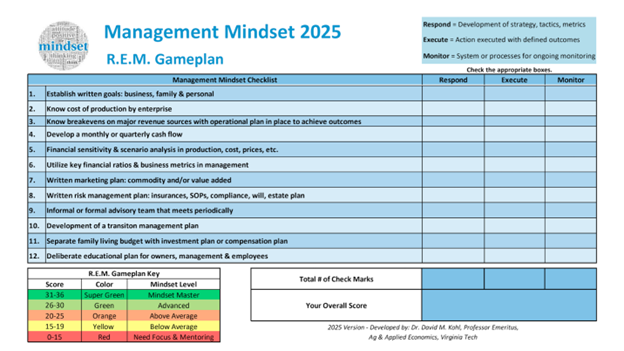In our unpredictable world of agriculture—where prices fluctuate, input costs vary, and extremes are the norm—planning is not just helpful, it is essential. Research shows that businesses with a written plan are four times more profitable. A Canadian study even found that farmers and ranchers with a solid business plan reported twice the mental resilience. The message is clear: a well-thought-out strategy is not just good for the bottom line—it is good for peace of mind, too.
In recent decades, our team developed the Business IQ assessment to evaluate the management mindset essential for business success. Many business owners and managers scored high, checking boxes on key areas like goal setting, cost of production, and long-term planning. However, we were disappointed to find that, once completed, these assessments were often filed away and forgotten for the rest of the year.
To place some rigor on the transformational planning process, we have developed a new guide using the acronym REM. That is, respond i.e., set aside time to develop the plan, then take the next step and actually execute the plan. Finally, periodically monitor performance throughout the year and make adjustments. Let's break these three components down with some real-life examples.
The first step in the planning process is actually responding. Any lender, consultant, mentor, or business partner will tell you the most frustrating aspect of working with people is they sometimes will not respond. Often, they are focused on what is urgent rather than what is important. Responding to key components of the business and operations must be deliberate with time allocated to developing a plan and strategy. Yes, emergencies often occur, but one must prioritize the important.
The next crucial step in a solid game plan is execution. In many cases, success comes down to timing—whether in production, marketing, or proactive operations, acting promptly can mean the difference between profit and loss. Experts across various fields—whether lenders, mentors, coaches, educators, or physicians—often say one of their greatest rewards is seeing individuals and businesses thrive as they put their plans into action.
A critical but often overlooked step is monitoring– tracking the outcomes, strategies, and actions after executing a plan. At our creamery, we create monthly cash flow projections and monitor cash flow weekly to quickly identify positive or negative shifts. Years of trend analysis help our owners and management team spot patterns and make objective decisions. Monitoring is essential across all areas of business, including production, marketing, risk management, and employee productivity.
As the saying goes, "What gets measured gets done." Tracking projections against actual results through variance analysis helps reveal the story behind the numbers. By applying the REM process across different areas of your business, you will gain valuable insights, make more informed decisions, and achieve greater peace of mind.
